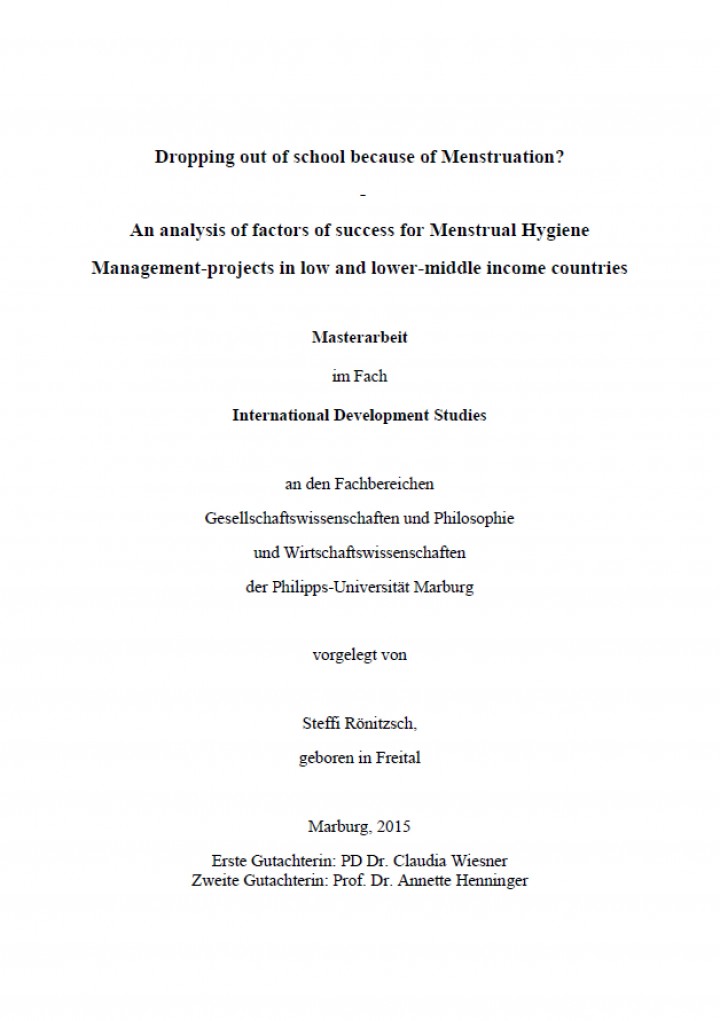Dropping out of school because of Menstruation? - An analysis of factors of success for Menstrual Hygiene Management-projects in low and lower-middle income countries
Roenitzsch, S. (2015)

Published in: 2015
Pages: 102
Publisher:
Masterarbeit, Philipps-Universität Marburg
Author:
Roenitzsch, S.
Uploaded by:
SuSanA Admin
Partner profile:
common upload
8290 Views
438 Downloads
Content - Summary
Gender equality is one of the main aims of the Millennium Development Goals (MDG). The fact that at some educational levels this equality is still not achieved has led to enquiries about the causes of the failure of this MDG. Former research reveals that many girls in developing countries are challenged by the management of menstruation in their educational settings. Absenteeism during menstruation is a consequential occurrence that can potentially lead girls to drop out of school completely. Developmental organisations thus established programmes aiming to improve the management of menstrual hygiene in the respective regions. While literature shows that menstrual hygiene management (MHM) has far broader potentials and can contribute to the fulfilment of other MDGs as well, for this particular thesis MHM-programmes were credited with the overall goals of increasing school attendance. The aim of this thesis is thus to analyse whether the interventions developmental organisations conduct in order to improve MHM also lead to improvements in school attendance. An answer is therefore sought to the research question: What are factors of success for Menstrual Hygiene Management in low and lower-middle income countries in order to improve school attendance among adolescent girls?
A common finding during this research is that the access to menstruation-related education and spreading awareness among communities and families regarding menstruation-related needs of adolescents are most important to improve girls’ school attendance. Therefore, a holistic culture-sensitive educational programme that raises knowledge and awareness not only among girls but also among their families, schools and communities has been found to be a key factor of success to keeping girls in school. Furthermore, access to adequate sanitary facilities and sanitary items constitute important necessities for female adolescents in school. Hence, the promotion of access to sanitary items and adequate sanitary infrastructure through involvement of local stakeholders to ensure a sustainable utilisation has been found to be another key factor of success. The opportunity to receive counselling and support as well as the access to pain killers was also mentioned, though less frequently. The experts interviewed here expressed that in addition to spreading awareness of, and increasing activity of hygiene behaviour, school performance, sustainability and institutionalization are favourable objectives of MHM-projects and should be considered as well. It was further suggested that collaboration with various stakeholders and including families, communities and schools, fosters widespread acceptance of the programmes as well as commitment and sustainability. These objectives often overlap and have the potential to foster the improvement of school attendance over the long run.
To generate these findings a qualitative research approach was applied. The research included a comparative analysis of four case studies as well as an analysis of seven interviews. The selected case studies highlight the execution of several MHM-interventions in Ghana, Nepal and Kenya. The quantitative effects of the interventions ‘provision of sanitary items’, ‘provision of education on menstruation’ and the combination of both on school attendance were evaluated. The results show that in so far as menstrual related absenteeism or the need for improving menstrual health was preliminary reported, all of the conducted interventions had a positive effect on the girls’ attendance in school. Hence, the interventions can be acknowledged as successful. The analysis of interviews with experts aimed to gather practical information about which specific interventions and factors are favourable in order to reduce menstruation-related absenteeism. Therefore, seven experts who work in the field on MHM in a developmental context were interviewed. The interviews were transcribed and afterwards categorized by the help of the software programme MAXQDA. Frequency tables and key statements of experts were used to identify the above mentioned key factors of success.
This research has focussed on the effect of MHM-interventions on school attendance of adolescents. Building on this thesis, an analysis of the effects of MHM-interventions on girls’ performance in school would enrich the understanding of these results. Such further analysis might include aspects such as a girl’s ability to concentrate, her participation in class (for example the courage to stand up and speak) and, if possible, even the development of her grades. A girl’s educational achievement is, in fact, much more significant than her actual attendance and is also more crucial for her future job opportunities and the overall utilisation of her potential. In this context, a need for long-term studies that investigate the effect of different types of interventions over a longer period of time is recommended for future large-scale research.
Bibliographic information
Roenitzsch, S. (2015). Dropping out of school because of Menstruation? - An analysis of factors of success for Menstrual Hygiene Management-projects in low and lower-middle income countries. Masterarbeit, Philipps-Universität Marburg
Filter tags
Case studies in other formats English Gender equality Menstrual Health and Hygiene (MHH)















